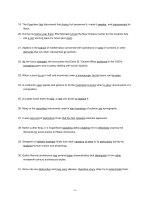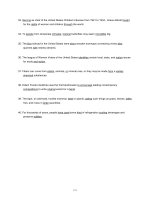Tài liệu TOEFL STUDY GUIDE PART 3 STRUCTURE AND WRITTEN EXPRESSION pdf
Bạn đang xem bản rút gọn của tài liệu. Xem và tải ngay bản đầy đủ của tài liệu tại đây (17.04 KB, 7 trang )
TOEFL STUDY GUIDE
PART 3
STRUCTURE AND WRITTEN EXPRESSION
Structure & Written Expression
Structure questions: test the ability to identify the correct structure
needed to complete a given sentence. The examinee reads
incomplete sentences. From the four responses provided for each
incomplete sentence, the examinees must choose the word or phrase
that best completes the given sentence. Only one of the choices fits
correctly into the particular sentence.
Written Expression questions: test the ability to recognize correct
grammar and to detect errors in standard written English. Here the
examinee reads sentences in which some words or phrases are
underlined. The examinee must identify the one underlined word or
phrase in each sentence that would not be accepted in standard
written English.
Test Design Features Tips 35 - 37
Tip 35 Structure (page 84)
Sentence Completion - 15 questions
Error Identification - 25 questions
Time: 25 minutes
Tip 36 Sentence Completion
For Sentence Completion you will be given a sentence that contains
a blank and asked to choose from the four choices the best possible
answer.
Use the two-pass system to answer the Sentence Completion
questions.
m First pass: answer all the questions that you see the anwer
right away.
m Second pass: go back and try to answer the harder questions.
GUESS if you still don't know.
Tip 37 Using POE to determine the correct answer
POE - Process of Elimination can increase your chances of
answering correctly. If you know an answer is wrong, you can
eliminate that choice and increase your chance of answering
correctly.
Structure and Written Expression: Grammar Tips 38 -
48
Structure: Grammar Tip 38
Nouns: a person, place, thing, or idea
Structure: Grammar Tip 39
Pronouns: A pronoun is a word that takes the place of a noun.
n Examples: he, she, his, it, her.
Structure: Grammar Tip 40
Verbs:/ A verb is an action word.
n Example: kicked, thought, are, felt.
Structure: Grammar Tip 41
Modifiers: used to describe another word
n Adjectives: describe nouns
n Adverbs: describe adjectives, verbs, and other adverbs
(many adverbs end in -ly)
Structure: Grammar Tip 42
Subject: The subject of a sentence is either a noun or a
pronoun. It tells you who or what is performing the action.
Structure: Grammar Tip 43
Articles: a, an and the are all articles.
Articles are used before nouns; "a" and "an" are used as nonspecific
modifiers and "the" is used as a specific modifier.
For example: "I put the book on a table."
"the book" shows that it was a specific book;
"on a table" shows that it was not a specific table.
If I said, "I put a book on the table", I mean that I put "a nonspecific
book or any book" on "the table" which means that it
was a specific table, one that I could point to or a specific
table that I was referring to.
"An" is used the same as "a" except that it is used before
nouns and adjectives starting with a vowel, such as "an
orange" or "an eye" or "an apple" or "an intense storm". "An"
is not used before the letter "Y"; you would use "a", such as
"a yellow towel" or "a young man" or "a yapping dog".
"A" and "an" are used to modify single nouns or adjectives
modifying single nouns. "The" can be used for both single
and plural modifiers; for example, "I put the books on the
table" or "I put the book on the table."
Structure: Grammar Tip 44
Prepositions: into, from, without, etc.
Note: the most common type of phrase on the TOEFL is the
prepositional phrase.
n Examples: "I went into the house"; "She read from
the cookbook".
Structure: Grammar Tip 45
Conjunctions: Conjunctions link words or word groups in a
sentence. Examples: and, or, but, etc.
n "I bought oranges, apples, and bananas."
n "We could go to the beach or to the park."
n "He would have gone to the movies but he was sick."
Structure : Grammar TIP 46
Sentences: Sentences must have both a subject and a
conjugated verb. It expresses a complete thought.
For example, "He went to the store".
"He" is the subject, "went" is the verb, and "to the store" is
the adverb clause telling where he went.
"Go!" is a complete sentence because it has a verb, "go" and
"you" is the implied subject. Command sentences such as
this don't often have a stated subject but it is understood that
"you" is the subject.









